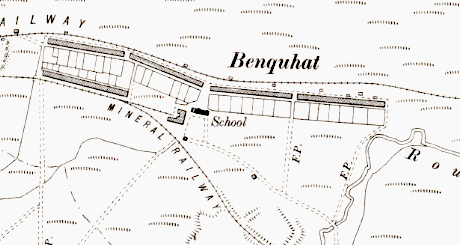Benquhat or Benwhat
On the hill above Dalmellignton and Patna, near to the villages of Lethanhill and Burnfoothill was the village of Benquhat, or Benwhat. The spelling varies depending on who you talk to. This will be a question for the villagers we meet in our project. The village was another one of the Dalmellington Iron Company settlements, created on the southern slopes of Benquhat Hill.

The first row built in the village was the Laight Row with thirty-four single apartment dwellings built in 1847. The village was expanded during the mining boom of the 1870s when four more rows were built. By 1881, the village had 772 people living in 131 houses, as the mines in the area gradually closed, the population fell steadily until by 1951, 460 people lived in Benquhat.[1]
The village had a store and school but no church. According to Tom Wilson, who was born in the village in 1926, there was a Sunday School held in the School building.[2] Fortnightly services were conducted by the minister from Dalmellington in the Old School for a time.[3] In 1926, the school roll increased and a new school was built. The Miner’s Institute was created in two houses at the end of the Laight Row offering the men (and boys over 14 years) a meeting and recreation space. It had snooker, carpet bowls, skittles, and dominoes. The Reading Room offered a small library and newspapers. Football was as ever a popular pastime in Benquhat with the local team the Benquhat Heatherbells playing on the old Corbie Craigs pit 5 hearth until it folded in 1931. Below is a photograph of the 1938 Ayrshire Crosscountry Championship coming through Benquhat. The winner was Peter Ardell from Ardeer Recreation, but local man Bobby Reid, No 40 in the picture, from the Doon Harriers won the following year taking both senior and junior titles.

The company store had a monopoly on supplying the village with their vans until the 1930s. Tom Wilson born in Benquhat in 1926 recalls the village as a ‘captive population’:
‘They actually went to the extreme measures to prevent them coming up. They put a big chain across what was originally the railway between Lethanhill and Benquhat, because we’re elevated here, we’re away up out of the valley. The Doon Valley had the railway into Dalmellington station, but we’re in an elevated situation away up Lethanhill and Benquhat. So to get up there, and they actually barred them. They put a chain across the road so only the company vans could get up. After 1936, after that sort of…, they hit that on the head.
In 1947, the Nation Coal Board acquired Benquhat and were keen to offload any older and poorer housing stock. Benquhat, similar to other Ayrshire mining villages, had basic amenities with few having running water or toilet facilities. Alice Wallace, who grew up as a small child in Benquhat in the late 1940s, described how some houses had outdoor toilets but these were mostly a bucket with a wooden seat and newspaper for toilet roll. The indoor toilet was a zinc pail that was emptied by the woman of the house in the morning. The poor state of the housing meant that the Ayrshire County Council prioritised the rehousing of the villagers to a new purpose-built estate in Dalmelling called Bellsbank, by 1951 all the villagers were cleared. On 16th November 1951, a reporter from the Ayrshire Post went up to the village and found eight families left. John Reilly at number 67, who was referred to as the ‘Provost’ by another villager, commented on the generous nature of the villagers remarked, ‘Aye, they could raise money for anything’ and that while it was a ‘fine place in summer’, in winter the snow drifts were so large you could walk on the roofs of the houses. Now, all that is left of the village is some foundations and the 1921 War Memorial.

We know about life in the village for women, thanks to Alice Wallace who kindly shared her autobiography with the project. Alice was born in Benquhat in 1945 and lived in the village until she moved to Bellsbank in 1951 with the rest of the village. The memories of her mum and other women in the villages are rich and detailed with descriptions of making rag rugs, reusing old wool, baking scones and keeping your house clean in tough conditions. Here she describes women washing the blankets with no running water in the house:
‘It was heavy work but had to be fitted along with all other work of the day. The women helped one another, usually working in pairs to get the water. Taking two pails at a time, one in each had, they went along to the water pumps at each end of the row. But it was not so easy as turning the tap either, they had to operate the pump to get water. Several trips of fetching and carrying were needed to have enough.’ [4]
Alice’s memories of her mother and the women in the village are crucial to reconstructing everyday life in the miner’s villages. We hope to hear more stories of women, men, and children’s lives in our villages. If you have memories of Benquhat you would like to share with us, please get in touch.
Further Reading:
- Dane Love, Ayrshire’s Lost Villages, (Carn: Auchinleck, 2017)
Footnotes
- Dane Love, Ayrshire’s Lost Villages,pp. 41-42
- Interview with Tom Wilson, interviewer Ian Dougall
- Dane Love, Ayrshire’s Lost Villages, p. 43
- Alice Wallce (nee Douglas), ‘Benquhat – Then What, 2019, p.16
